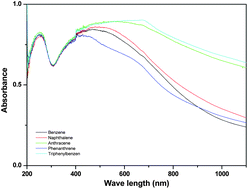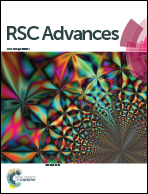Novel microporous hypercross-linked conjugated quinonoid chromophores with broad light absorption and CO2 sorption characteristics†
Abstract
We have discovered formation of hypercross-linked conjugated quinonoid chromophores (polymers) with broad light absorption characteristics during cross-linking of aromatic monomers, such as benzene, naphthalene, anthracene, phenanthrene and 1,3,5-trimethyl benzene with 1,3,5-trioxane in the presence of an FeCl3 catalyst. The para or ortho –CH2 groups that bridge aromatic monomers were dehydrogenated during polymerization to form the quinonoids. The quinonoid chromophores were confirmed by their DRS-UV Vis and FTIR spectra. We have also discovered similar such quinonoid chromophores in the hypercross-linked polymers of aromatic monomers, reported from 1970 onwards by different research groups. The polymers were synthesized by similar experiments with an FeCl3 catalyst, and brown colored. As all the polymers bear low band gaps, they strongly absorb light covering the wavelength range of 1000 to 200 nm. Most of the hypercross-linked polymer matrices carry microporous spheres of about 1 to 5 μm diameter and showed 6–7% CO2 sorption. The polymers with their low band gaps will inspire research on semiconductors, solar cell devices, UV stabilizers/absorbers and infrared absorbers/detectors, molecular sensors and academic study.


 Please wait while we load your content...
Please wait while we load your content...